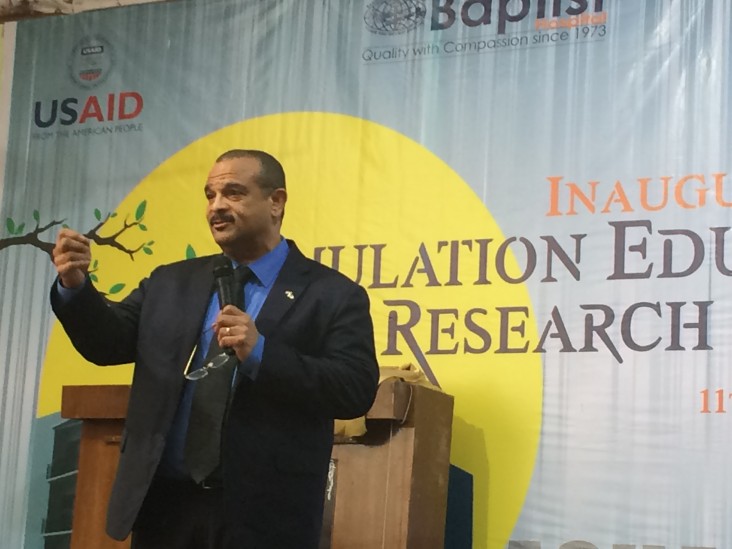India
- History
- Our Work
- Transforming Development Through Innovation & Partnership
- U.S.-India Triangular Cooperation
- Partnership for Energy Access and Security
- Partnership for Sustainable Forests in India
- Partnerships for Health
- Partnership for Education
- Partnership for Water Sanitation and Hygiene (WASH)
- Partnership for Food Security
- Partnership for Gender Equality
- Investing in Afghanistan
- Foreign Assistance Data
- Newsroom
- Newsletters and Fact Sheets
- Speeches
- Resources For Implementing Partners (RFIP)
- Careers
- Partnership Opportunities
- Success Stories
Speeches Shim

(As prepared for delivery)
Good morning distinguished guests, fellow speakers, members of the press, ladies and gentlemen. Thank you for the kind invitation to speak with you all today. It is such a pleasure to be here.
As I look around the room, I see people who are compassionate and who believe in serving the community and people to the best of their abilities. It also gives a reassurance that we have partnered with the right people to help us improve lives and build healthy societies.
An African proverb beautifully captures this importance of partnership. It goes like this: “If you want to go fast, go alone. If you want to go far, go together.”
Partnerships reflect the complexity of our society, as well as its interconnectivity. We all recognize that each of us makes better progress when we work together rather than alone.
U.S. development assistance in India has followed a similar trajectory. In the late 1970s, USAID projects included rural electrification, fertilizer promotion, agricultural credit, integrated health and population programs, irrigation schemes and social forestry.
By the mid-1980’s, the USAID program shifted to focus on science and technology with an emphasis on policy and institutional reforms. Projects addressed agricultural research, alternative energy technology development, biomedical research, water resources management and family planning. Technology transfer and institution capacity building were integral to these activities.
Today, USAID efforts in India mark a shift from the traditional donor-recipient relationship to a strategic partnership of equals. USAID’s partnership with India has continued to evolve with the changing priorities and challenges faced by our two nations. These include improving the health of vulnerable populations in India and accelerating India’s transition to an environment-friendly country.
Access to quality healthcare is one of the most important needs of vulnerable populations across India. General Nurse Midwives and Auxiliary Nurse Midwives are the backbone of the healthcare service delivery system. However, there is an acute shortage of adequately trained Auxiliary Nurse Midwives and staff nurses in many of the high priority and vulnerable regions. This problem is compounded by the sub-optimal quality of pre-service education at nursing educational institutions in priority states.
There are a multitude of factors that influence the quality of education and training of this important workforce. Limited trained faculty, outdated training curricula and materials, poorly equipped teaching laboratories, and limited clinical practice opportunities are just a few of the barriers.
And that brings us to why this project, a partnership between American Schools and Hospitals Abroad (ASHA), Bangalore Baptist Hospital and Baylor University School of Nursing is so important and timely.
USAID is very pleased to be part of this partnership to build a simulation training and education center for nursing excellence. This center will not only provide a space for learning but also provide safe living accommodations for nurses to live and thrive. I am particularly impressed by the cutting-edge simulation laboratory for nurses and doctors.
USAID technical support to build state of the art simulation skill labs in the private sector is a great opportunity for experience sharing and replication. We applaud this brilliant initiative from ASHA, and its contribution towards India’s development goals.
For over 60 years, ASHA – through its partners – has shared and advanced the best in American health and education innovations and approaches worldwide. These efforts have built amazing bridges of understanding and friendship between the people of the United States and the people of many other countries.
ASHA’s portfolio of awards directly contributes to advancing the USAID goals of promoting resilience and reducing global poverty, as well as the United States Government’s goal to build strong, resilient societies. USAID recognizes that the impact of ASHA assistance reaches far beyond the local communities served by a given school or hospital.
ASHA has created a worldwide legacy of outstanding educational institutions and hospitals that have educated successive generations of researchers and leaders as well as built local technology bases for integrated research and healthcare.
In closing, I want to re-emphasize the value and importance of partnerships in our mutual development and diplomatic efforts.
I can think of no better partnership than what we have between the United States and India to solve pressing development challenges facing the world. Through decades of partnerships, we have emerged stronger and better.
Thank you!
Related Speeches
- Deputy Administrator Glick's Remarks at the AJC Virtual Summit on U.S.-India-Israel Relations
- Remarks by Acting Mission Director Ramona El Hamzaoui at the Workshop on Regional Cooperation for Modernization of Power Distribution in South Asia
- Remarks by Acting Mission Director Ramona El Hamzaoui at the Antimicrobial Resistance Summit: One World, One Health, One Fight

Comment
Make a general inquiry or suggest an improvement.